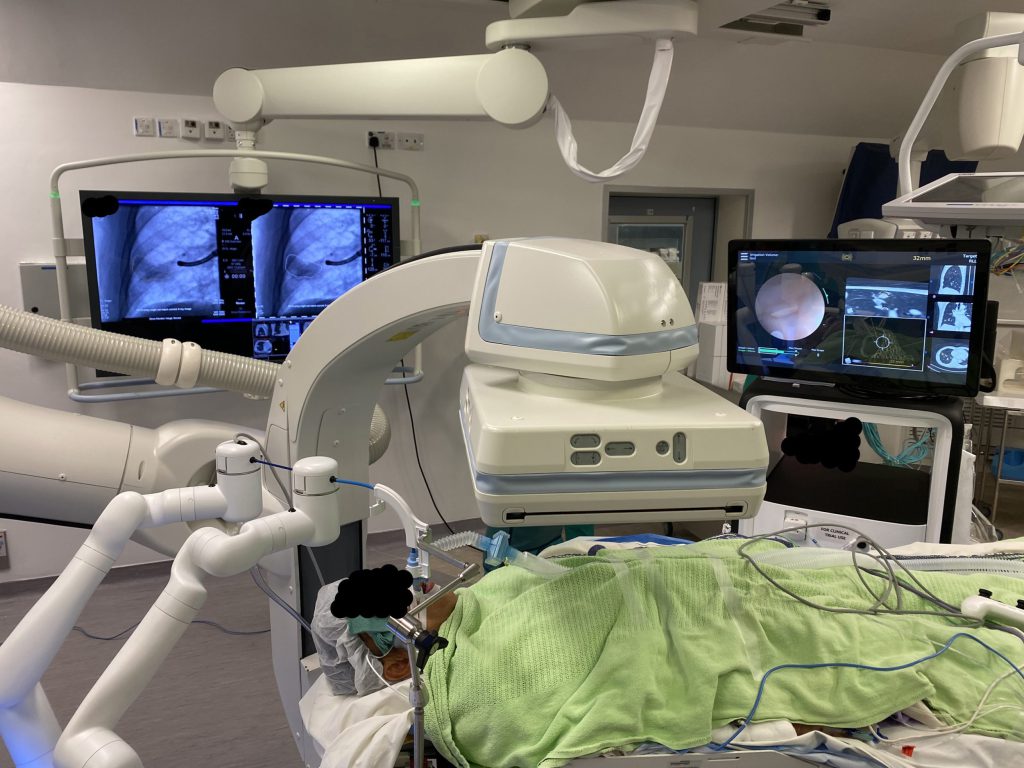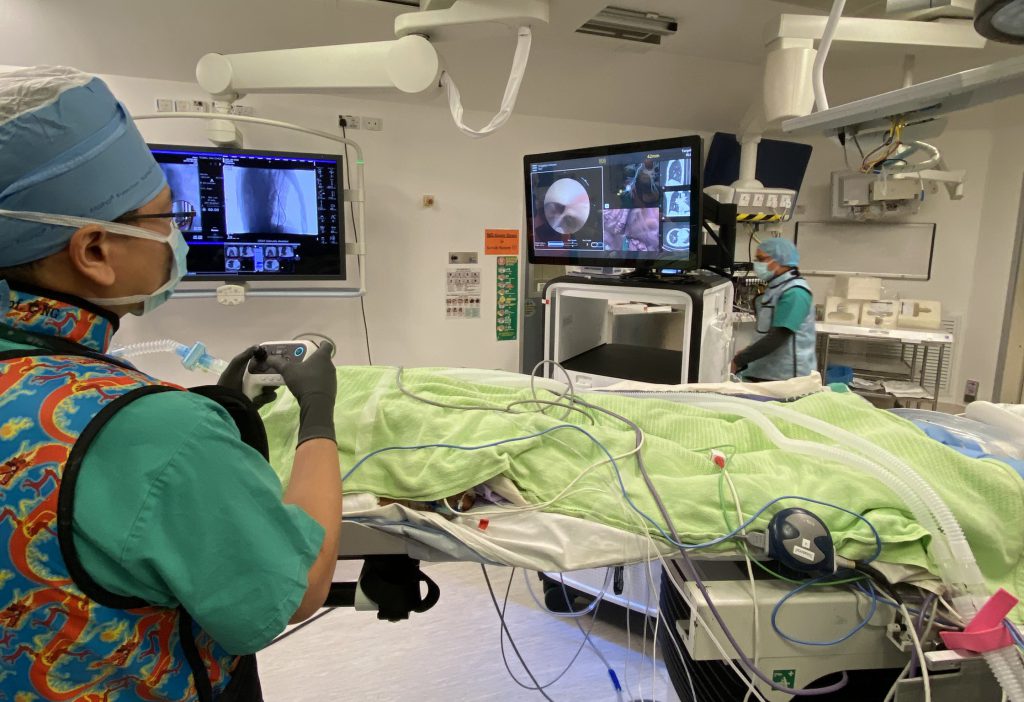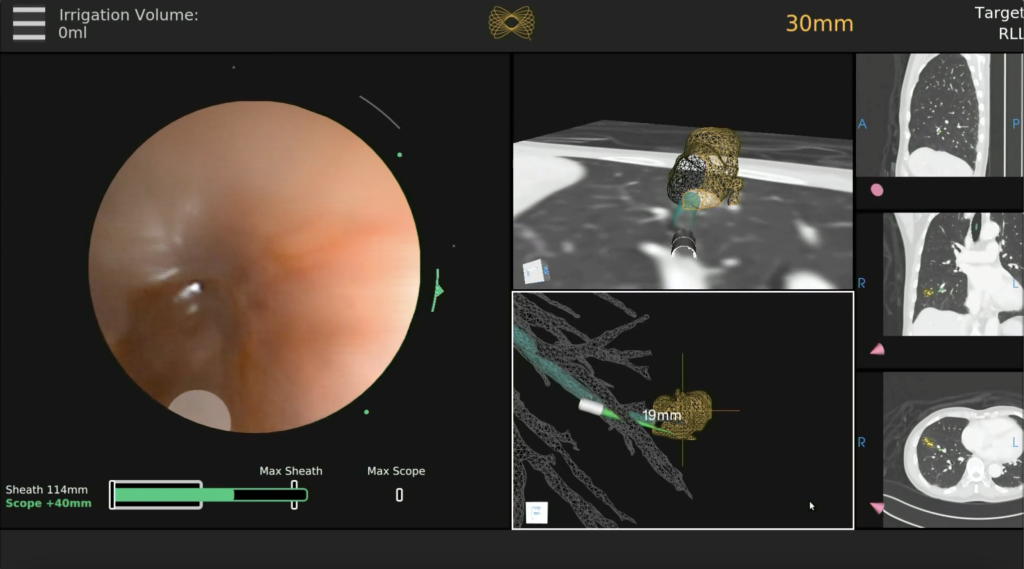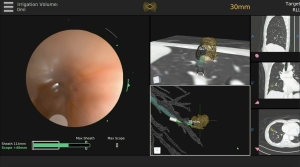CUHK
News Centre
CUHK performs the first hybrid operating room robotic-assisted bronchoscopy procedure outside the US
Diagnosing small and peripheral pulmonary lesions that can be early manifestations of lung cancer remains a challenge. The Chinese University of Hong Kong’s (CUHK) Faculty of Medicine (CU Medicine) has become the first institution outside the US to perform the hybrid operating room robotic-assisted bronchoscopy procedure, with 18 successful cases since December 2021. This novel procedure allows physicians to accurately access tiny and hard-to-reach lung nodules, enabling biopsy for early diagnosis and treatment of lung diseases. It is now in clinical trial, with a target of enrolling up to 1,200 patients worldwide.
Robotic-assisted bronchoscopy improves accuracy in locating lung tumours and greatly enhances stability of the procedure
Lung cancer is the leading cancer killer in Hong Kong, according to the Hong Kong Cancer Registry, with more than 4,000 people dying of the disease in 2019.
With growing awareness and use of medical imaging, increasing numbers of small lung nodules are often found deep within the lungs, where they are difficult to reach. Biopsy to obtain tissue from these nodules for early diagnosis of lung cancer remains a challenge. The method of biopsy used often depends on the size and position of the lesion. Conventional bronchoscopy usually can only reach the more central parts of the lung while electromagnetic navigation bronchoscopy can go further into the peripheral or even the most distal areas with very fine, flexible catheters and tools. The latest robotic-assisted bronchoscopy platform offers additional advantages over previous bronchoscopy systems.
Dr. Rainbow Wing Hung LAU, Clinical Assistant Professor (honorary), Division of Cardiothoracic Surgery, Department of Surgery at CU Medicine, explained, “Bronchoscopy is a form of endoscopic procedure, usually performed by doctors specialising in lung disorders. Conventional diagnostic options available for lung cancer have limitations in accuracy, safety or invasiveness. These limitations can lead to false negatives, and complications such as pneumothorax and haemorrhage. The novel robotic-assisted bronchoscopy uses real-time optical imaging and electromagnetic positioning to enable the operator to navigate the complex human airways. The procedure is performed using a remote console that is linked with the robotic arms and bronchoscope to accurately drive the device to the desired location within the lung. The advanced robotic mechanism within the bronchoscope also maintains stability while tools are deployed for biopsy, improving accuracy of lesion localisation and diagnostic yield.”
CU Medicine is a pioneer in thoracic surgical treatments in the Asia-Pacific region
The thoracic surgical team at CU Medicine has been pioneering advanced minimally invasive techniques using the latest technologies, including single port video-assisted thoracoscopic surgery for major lung resection, image-guided surgery in the Hybrid Operating Room, and transbronchial microwave ablation for treatment of lung tumours.
Professor Calvin Sze Hang NG, Professor from the Division of Cardiothoracic Surgery, Department of Surgery at CU Medicine remarked, “We are very excited to have performed the first hybrid operating room robotic-assisted bronchoscopy in the Asia-Pacific region. The technology has been utilised in the US since 2018 with excellent outcomes. In the 18 cases performed thus far by our team, we have been able to successfully reach all the lung lesions for biopsy or for dye marking lung resection.”
“We now have a tool to accurately access tiny and hard-to-reach lung nodules with greater precision than ever before. The improved diagnostic yield from novel robotic-assisted bronchoscopy platforms such as this compared with conventional bronchoscopy will allow earlier cancer diagnosis and fewer repeat procedures, potentially saving costs, and ultimately providing a better patient experience and clinical outcome,” he added.
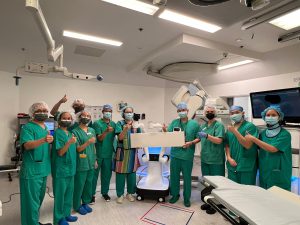
CU Medicine has become the first institution outside the US to perform the hybrid operating room robotic-assisted bronchoscopy procedure. This novel procedure allows physicians to accurately access tiny and hard-to-reach lung nodules, enabling biopsy for early diagnosis and treatment of lung diseases.
Professor Calvin NG (4th from the right) and Dr. Rainbow LAU (6th from the left) from the Division of Cardiothoracic Surgery, Department of Surgery at CU Medicine with research team.
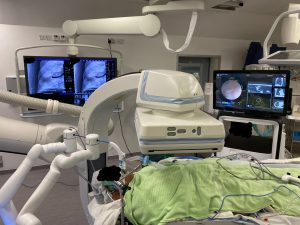
The novel robotic-assisted bronchoscopy uses real-time optical imaging and electromagnetic positioning to enable the operator to navigate the complex human airways.
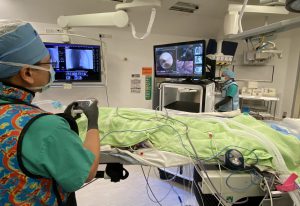
The procedure is performed using a remote console that is linked with the robotic arms and bronchoscope to accurately drive the device to the desired location within the lung. The advanced robotic mechanism within the bronchoscope also maintains stability while tools are deployed for biopsy, improving accuracy of lesion localisation and diagnostic yield.



